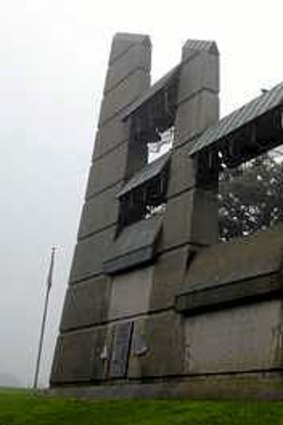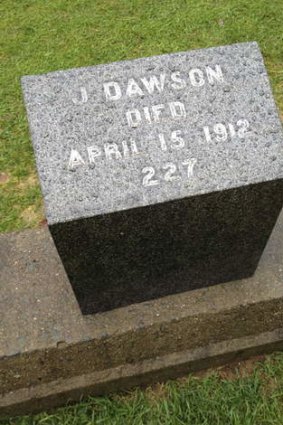This was published 10 years ago
Halifax explodes
The tragic Titanic sinking is remembered, but signs of another massive disaster are all around this city.
By Tim Richards

The memorial bell tower in Halifax, Canada, is on a hill above the historic explosion's epicentre.Credit: Tim Richards
The inscription is simple: "J. Dawson, died April 15, 1912."
The date is a famous one: the night the SS Titanic sank in the North Atlantic. But could this really be Jack Dawson, the character portrayed by Leonardo DiCaprio in the epic movie Titanic?
Well, no. The rain-speckled granite headstone (pictured) I'm looking at in Fairview Lawn Cemetery in Halifax, Canada, is the final resting place of Joseph Dawson, a Titanic crewman who shovelled coal.

The inscription is simple.Credit: Tim Richards
His body was retrieved by Halifax's cable-laying ships, assigned the grim task of recovering the dead. Those they found mostly ended up here, beneath headstones paid for by the White Star Line.
Five years after the Titanic sinking, Halifax was struck by another massive disaster, which the world has largely forgotten. On the morning of December 6, 1917, at the narrowest point of Halifax's harbour, a Norwegian supply ship struck an explosives-packed French munitions ship on its way to war-torn Europe, setting it on fire.
The resulting explosion was the largest man-made detonation in history before the atomic bomb. Five square kilometres of the city was obliterated, with 2000 deaths and 10,000 injuries. In the city's Maritime Museum, an exhibition tells the tale through astounding before-and-after photos and oral accounts from survivors.
Halifax has never forgotten its most disastrous moment, and there are intriguing reminders, large and small, across the city. The day I visit Fort Needham Memorial Park, on a hill above the explosion's epicentre, thick Atlantic fog wreathes the memorial bell tower.
It's not pretty, but it is striking - a giant set of sloping concrete sections representing jagged ruins. It holds 14 memorial bells, donated by a woman who lost her entire family in the disaster and who was blown by its force up on to this hill.
Clambering down the other side of the slope I reach the Hydrostone District, itself a legacy of the explosion. Built as a 1920s "garden city" to house those made homeless, it's a beautiful neighbourhood of homes set along broad tree-lined streets, with a gentrified shopping strip next to a village green.
In the city centre are more fragments of that calamitous day. One face of the City Hall's clock is forever stopped at 9.05am, the time of the explosion. In St Paul's Church opposite, a chunk of metal from the blast is embedded near the ceiling.
In the foggy evening I peer my way to Five Fishermen (1740 Argyle Street), an upmarket seafood restaurant that serves an excellent parmesan-crusted halibut ($39).
It also happens to be a former funeral home, where the richest victims of the Titanic disaster were laid out a century ago. It seems Halifax's dramatic maritime history is never far away, even at dinner.
Tim Richards travelled courtesy of the Canadian Tourism Commission.
Fact file
WHERE The Maritime Museum of the Atlantic is open 9.30am-5pm daily, entry $8.50.
GETTING THERE Air Canada flies to Halifax from $2700 economy return ex Melbourne.
ACCOMMODATION Westin Nova Scotian - modern comfort from $150 a night. The Waverley - boutique lodgings once graced by Oscar Wilde, from $110 a night.
Sign up for the Traveller newsletter
The latest travel news, tips and inspiration delivered to your inbox. Sign up now.